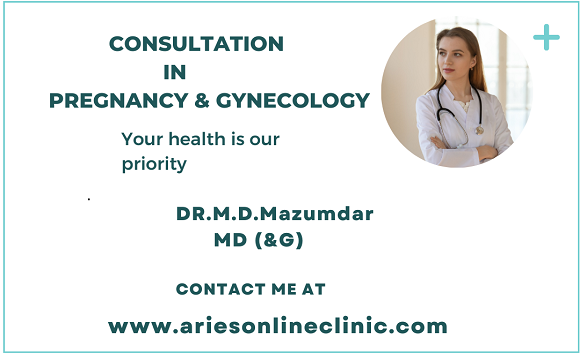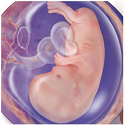Sore Breasts in Pregnancy
Written by Dr.M.D.Mazumdar, MD
The first sign of pregnancy for many women, are sore and sensitive breasts.
Breast soreness can occur as early as 1-2 weeks after fertilization and conception, or even before the first missed periods. Most however feel their breasts becoming sore at about 4-6 weeks after the first missed periods.

Some women describe the soreness as similar to the changes that occur just before menstruation, only much more intense.
Sometimes the soreness may be so severe that the touch of anything even the fabric of the nightgown may cause discomfort. The nipples may throb or tingle and the breast feel swollen and heavy. You may feel that walking about, mild exercise or even sleeping on your stomach can make you uncomfortable.
Breast Changes
As soon as you become pregnant, there is a surge of the female hormones, progesterone and oestrogen in your body. These hormones not only help the uterus to grow and maintain the pregnancy, they also prepare the breasts for feeding the baby when the baby is born.
Although the breasts grow throughout your pregnancy, it is in the first trimester that you are more aware of the changes, especially if it happens to be your first pregnancy as well.
The glandular tissue in the breasts begins to grow and increase in size as pregnancy progresses. Milk ducts begin to form and increase in number. The alveoli (please see anatomy of the breasts), which are the main milk producing areas, become larger with growth of more cells. This is more so in the first pregnancy. In later pregnancies, the breasts may enlarge very little or sometimes not at all.
The increase in size depends to some extent on heredity, on how much weight you put on and how big the breasts were before you became pregnant.
The blood vessels supplying blood to the breasts increase in both size and number. You may see prominent blue veins running under the skin of your breasts.
A layer of fat is deposited under the skin to support the bulk of the breast tissue and increase milk production. This fat layer together with the increasing mass of breast tissue will make the cup size of your bra go up by about 2 sizes by the time you reach term pregnancy. Some women may go up from a size 34B to a 36C or even more.
The nipples become large and prominent. Pigmentation occurs to make them appear darker than before. This pigmentation may decrease after delivery but never reaches the pre-pregnant state.
The areola, that is the dark area around the nipples appears to spread out more and become darker. An ill-defined secondary areola sometimes appears surrounding the main areola which is called the primary areola. It is less dark in colour and its margin merges gradually with the surrounding skin.
Small oil-producing glands called Montgomery's tubercles become prominent around the edges of the primary areola. They look like small irregular bumps that are firm but painless. These tubercles, meant to keep the areola and nipples moisturized and supple are also present during the non-pregnant stage but can barely be seen.

Itching can occur while the stria or stretch marks are developing. This is due to the injury to the elastin fibres of the breast skin when it is stretched too much.
Some women may notice that their breasts begin to leak a thin, yellowish white liquid as they near the end of their pregnancies in the third trimester. This liquid, called colostrum, is rich in many essential nutrients and vitamins and is the first food that the baby gets after birth. Leakage of colostrum is just a sign of the body preparing the breasts for breastfeedng the new baby.
Not all women however get all the breast changes. Many do not have any soreness of the breasts, or if present, may be very mild. Breast enlargement may be minimal. Stria may not appear if the breasts are not very enlarged. Colostrum may not leak. These are also quite normal and does affect breastfeeding in any way.
As pregnancy advances, you will find that the breasts become less sore and sensitive, although some women do complain of soreness from time to time.
What you can do for Sore Breasts
If you are on the heavier side, buy a plus-sized bra with wide straps that can take on the added weight easily.
Ask a professional at a department store or maternity store to fit you up. If this is not possible, measure yourself along the widest circumference of your chest, usually over the nipples for your cup size and just under your breasts for your chest size.
You may need to be fitted more than once as the breasts continue to develop throughout pregnancy. Buy a bra that fits when the clasp is on the tightest setting. You will then have room to let them out as your ribs expand in later pregnancy. You can also use bra extenders to adjust for the enlargement of your chest wall in later pregnancy.
If you are planning to breastfeed your baby, buy special maternity bras. These should be bought towards the end of the pregnancy at around the 36th week when the breasts have more or less attained the full pregnancy size. Avoid underwire bras, as under wires can put pressure on milk glands and interfere with milk production.
Pregnancy Sleep Bras: If you feel that the bra chafes your nipples at night, buy a soft pregnancy sleep bra. This is a soft cotton bra with no seams that will prevent sagging of your breasts. Many women also find a camisole and shorty set very comfortable to sleep in at night.
Sports Bras: If you plan to exercise, it is important to invest in a well fitting sports bra designed primarily to support your heavy breasts during exercise. Many women prefer to wear sports bras throughout their pregnancies. Less movement of the breasts cause less soreness.
Read More:
Also Read-
- Fatigue in Pregnancy.
- Polycystic Ovarian Syndrome- Causes, Symptoms, Treatment..
- Vaginal Discharge with Itching .
- Female Reproductive Anatomy - Uterus, ovaries, vagina etc.
Do you have a gynecological or obstetrical problem? Would you like to discuss it in private? Consult our online gynecologist Dr.M.D.Mazumdar, MD (O&G), at any time you want and get your reply within 24 hours.We charge a nominal fee of USD 20 ($20) per question through Paypal.com.
The procedure of asking a question is quite simple. Clicking on the link below takes you to the Paypal website where the payment is made. After the payment goes through, you will be directed back to this website where you can ask your question. And rest assured, you will get your answer within 24 hours. And usually, even sooner.



